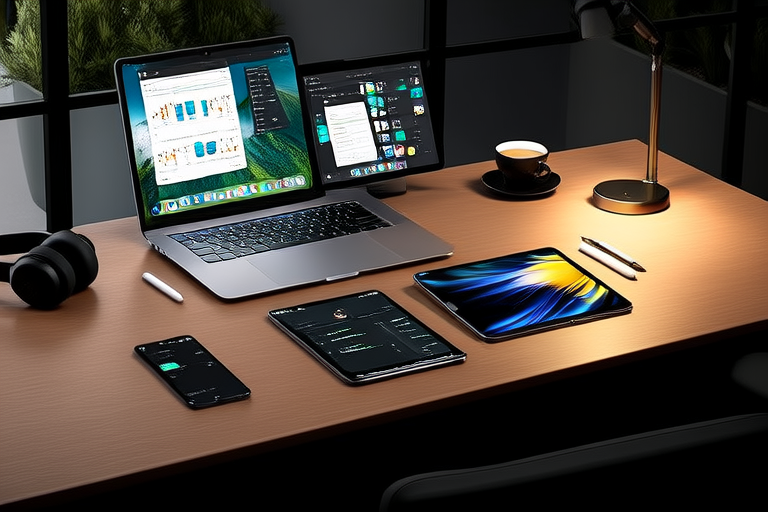“`html
Mastering Productivity: Tips for Using Smartphones and Tablets Efficiently
Introduction
In today’s fast-paced world, productivity has become more important than ever. Whether you’re managing a busy schedule or juggling multiple projects, being efficient can make all the difference. Smartphones and tablets have evolved from mere communication tools to indispensable devices that facilitate both personal and professional tasks. These portable gadgets offer a wide range of functionalities, making it easier to stay connected, organized, and productive.
This article aims to provide practical tips to help you maximize the efficiency of your smartphone and tablet. By following these guidelines, you can streamline your digital workspace, leverage built-in features, optimize app usage, set boundaries, and ensure security. Let’s dive into the details!
1. Organize Your Digital Workspace
Just like a cluttered desk can hinder productivity, an unorganized digital workspace can slow you down. Keeping your smartphone and tablet organized is crucial for maintaining efficiency.
- Use Folders to Categorize Apps: Group similar apps together in folders to reduce visual clutter and make navigation easier. For example, create folders for work-related apps, social media, entertainment, etc.
- Remove Unused Apps: Uninstall apps you no longer use to free up space and declutter your home screen. A clean home screen allows you to focus on the apps that matter most.
- Utilize Widgets Effectively: Widgets can provide quick access to frequently used information, such as weather updates, calendars, or news headlines. Place them strategically on your home screen for easy reference.
2. Leverage Built-in Features
Your smartphone and tablet come equipped with numerous built-in features designed to enhance productivity. Taking full advantage of these tools can significantly improve your workflow.
- Voice Assistants: Voice assistants like Siri, Google Assistant, and Bixby can handle quick tasks without requiring you to manually navigate through menus. Use voice commands to send texts, set reminders, or search for information.
- Digital Assistants for Reminders and Scheduling: Many smartphones have built-in calendar and reminder apps that can be synced across devices. Set recurring reminders and appointments to keep track of important events.
- Keyboard Shortcuts: Familiarize yourself with keyboard shortcuts for faster navigation. For instance, swiping left or right on a word to delete or select it can save time compared to tapping multiple keys.
3. Optimize App Usage
The right apps can transform your smartphone or tablet into a powerful productivity tool. However, it’s important to choose apps wisely and use them effectively.
- Task Management Apps: Tools like Todoist and Trello help you organize tasks, set priorities, and track progress. They often include features like deadlines, labels, and collaboration options, making them ideal for both individual and team projects.
- Note-Taking Apps: Evernote and Notion are excellent for capturing ideas, organizing notes, and creating to-do lists. These apps allow you to sync your notes across devices, ensuring you always have access to your information.
- Email Clients Optimized for Mobile Use: Some email clients are specifically designed for mobile devices, offering features like swipe-to-delete, quick reply, and smart filters. Gmail, Outlook, and Yahoo Mail are popular choices.
- Explore App Reviews Before Downloading: Before adding new apps to your device, read reviews and check ratings to ensure they meet your needs. This will help you avoid downloading apps that may not be worth the storage space or battery consumption.
4. Set Boundaries and Manage Notifications
One of the biggest challenges to productivity is the constant stream of notifications. These interruptions can derail your focus and reduce overall efficiency. It’s important to manage notifications effectively to maintain a productive workflow.
- Turn Off Non-Essential Notifications: Disable notifications for apps that don’t require immediate attention. For example, turn off social media notifications unless you need real-time alerts.
- Use Do Not Disturb Mode During Focused Work Sessions: Activate Do Not Disturb mode to block all incoming calls, texts, and notifications. Schedule it for specific times or set it to activate automatically during certain hours.
- Set Specific Times to Check Emails and Messages: Instead of checking your inbox every few minutes, designate specific times to review and respond to emails and messages. This reduces distractions and helps you stay focused on other tasks.
5. Stay Secure While Staying Connected
With the increasing reliance on mobile devices, ensuring their security is paramount. Cybersecurity threats are real, and protecting your personal and sensitive data is crucial.
- Enable Biometric Authentication: Use fingerprint or facial recognition to secure your device. Biometric authentication is faster and more convenient than traditional PINs or passwords.
- Regularly Update Software: Keep your operating system and apps up to date to protect against vulnerabilities. Developers frequently release updates that patch security flaws and improve performance.
- Be Cautious About Public Wi-Fi Usage: Avoid accessing sensitive information over public Wi-Fi networks. If you must connect, use a virtual private network (VPN) to encrypt your data and protect your privacy.
Conclusion
By organizing your digital workspace, leveraging built-in features, optimizing app usage, setting boundaries, and ensuring security, you can significantly enhance your productivity with smartphones and tablets. Each tip offers a unique way to streamline your workflow and make the most out of your mobile devices.
Remember, the key to mastering productivity lies in finding the methods that work best for you. Experiment with different approaches and techniques until you discover the combination that maximizes your efficiency. With the right mindset and practices, your smartphone and tablet can become invaluable tools in your pursuit of productivity.
“`


